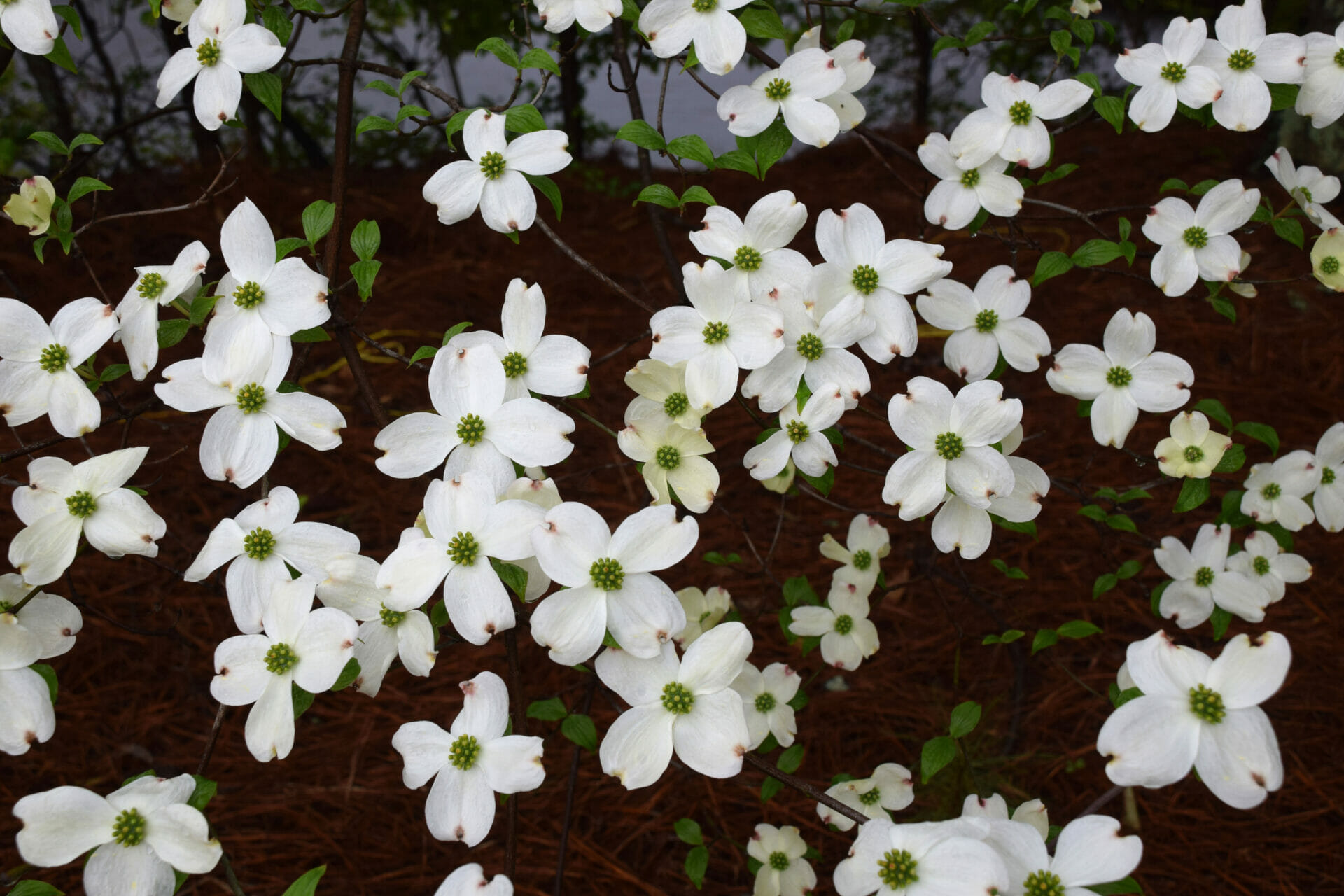
Dogwood (Cornus florida). Photo by Ellen Honeycutt.
In this issue ...
- Washington Post feature on native plants
- Working with homeowner associations
- Spotlight on foamflower
- Important wildlife legislation
- Plant sales, other outdoor events, and more in Chapter News
Breaking news: Washington Post highlights native plants
In an article first posted on April 5 (free sharable link), the Washington Post starts with the following:
In an era of climate change, homeowners and landscapers are learning what ecologists have known for decades: It’s time to shed the mighty American lawn in favor of native plants and perennials.
Check out the article, which includes a story about dealing with homeowner associations (and see our next article below for more on that topic).
Opportunity to Make a Difference: Join a State Committee to Address HOA Policies
Lori Conway
If you’ve read our new strategic plan, you know we have a number of ambitious goals, including helping our members grow a better landscape. We know many members live in neighborhoods where homeowner association (HOA) landscaping covenants might present challenges for our goals of planting native, reducing lawns, and curtailing the use of chemicals. The state board routinely fields the question of “How can I convince my HOA to change their policies?”
The answer lies in a multi-pronged approach that includes education on both sides of the fence, thoughtful plant selection, garden certification/signage, and using “cues of care” to meet cultural expectations for maintenance. This is an issue that cuts across all parts of Georgia.
We’d like to see a committee formed to study and assimilate best practices on this issue. Where have people been successful in lobbying their HOAs for change and how? We’d like to package these strategies and develop tools that our chapters and members can easily access and use. This would include things like
- collections of photos of pleasing native landscapes in all regions across the state that demonstrate effective cues of care,
- simple slide presentations to present to HOA boards on why invasive plants (particularly Bermuda lawns) are so damaging, why planting native is important, and proving how it can be done in a beautiful manner.
If you’d like to work on developing these valuable resources for our members, please write to us at strategic@gnps.org.
Plant Spotlight: Foamflower
Ellen Honeycutt
 Foamflower (Tiarella spp.) gracing a woodland path at Southern Highlands Reserve in North Carolina.
Foamflower (Tiarella spp.) is a common spring-blooming native perennial in north and southwest Georgia. It is also one of our most widely sold spring flowers thanks to nurseries that have found it easy to propagate and hybridize. In natural areas, find it in moist forests with good drainage. A few leaves often remain year-round, although they may be flat on the ground. In April, look for thin stems of white-pink flowers; the flowers are arranged in a raceme and open from the bottom.
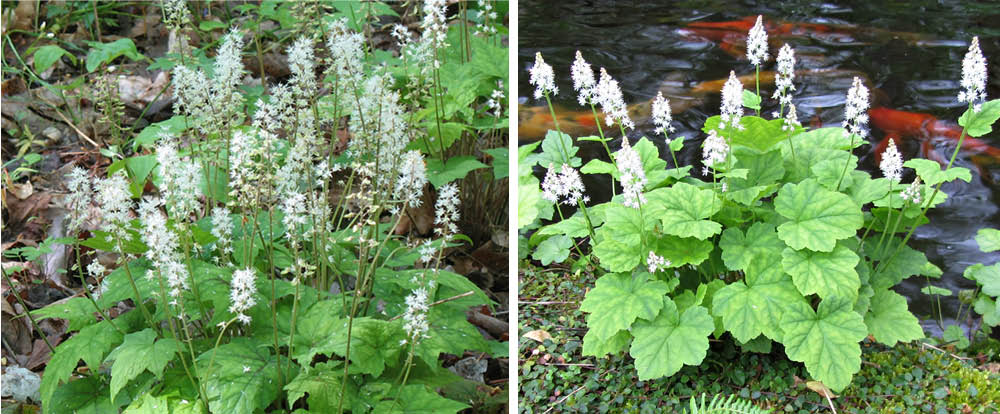
Tiarella wherryi (left) and Tiarella nautila (right).
Naturally, Georgia has several species of foamflower with most being sold as Tiarella cordifolia which is a clumping species. Tiarella wherryi and Tiarella nautila are also clumping species. There are stoloniferous species as well: Tiarella austrina is considered to be in Georgia while T. stolonifera is not. There is a new article out by Guy Nesom with some recent research on Tiarella species and what he considers to be their natural range. Some species are best identified while in bloom. I can already tell from some old photos that what I thought was Tiarella cordifolia is probably T. nautila.
If you’re shopping for part-shade perennials, foamflower is a good choice if it is in your range. You might find plants called Heucherella for sale – that’s a nursery-bred hybrid between Tiarella and its Saxifragaceae family relative Heuchera. Foamflower needs good drainage, so mix in a few bits of rock or gravel when planting if necessary. If you can encourage moss to grow in the same area, you just might get some babies in the future.
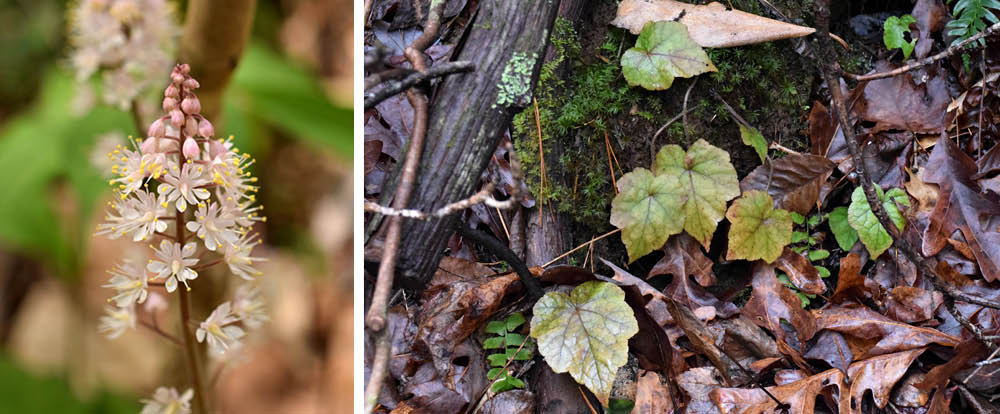
Closeup of foamflower bloom (left) and the stoloniferous species Tiarella austrina (right).
Call to Action: Support for RAWA
Lori Conway
If you tuned in to our February symposium, you heard both of our two prominent state conservation leaders, Mincy Moffett and Jennifer Ceska, speak strongly about the need for GNPS members to ask our congressional members to support the Recovering America’s Wildlife Act (RAWA). This is federal legislation to provide critical funding for efforts to restore essential habitat and implement key conservation strategies, as described in each state’s Wildlife Action Plan (WAP). Georgia’s WAP was first written in 2005, updated in 2015, and will be re-updated in 2025, provided this critical funding bill passes into law. If you’ve never read the Georgia WAP, we strongly encourage you to review it. In fact, on page H-10 of the plan’s Appendix H, you’ll find GNPS mentioned as a key collaborator in plant conservation efforts through our signature plant rescue program and propagation efforts. This is why you, our members, are a critical component of the conservation efforts in Georgia.
If it passes, the Georgia Wildlife Federation estimates that $27.8 million will come to Georgia each year to help hundreds of troubled plants and wildlife before they face more dire risks and recovery efforts become significantly more expensive. We urge you to write your representatives to support this bill. The Georgia Wildlife Federation’s website makes it easy for you to do so at https://gwf.org/rawa/.
Chapter News
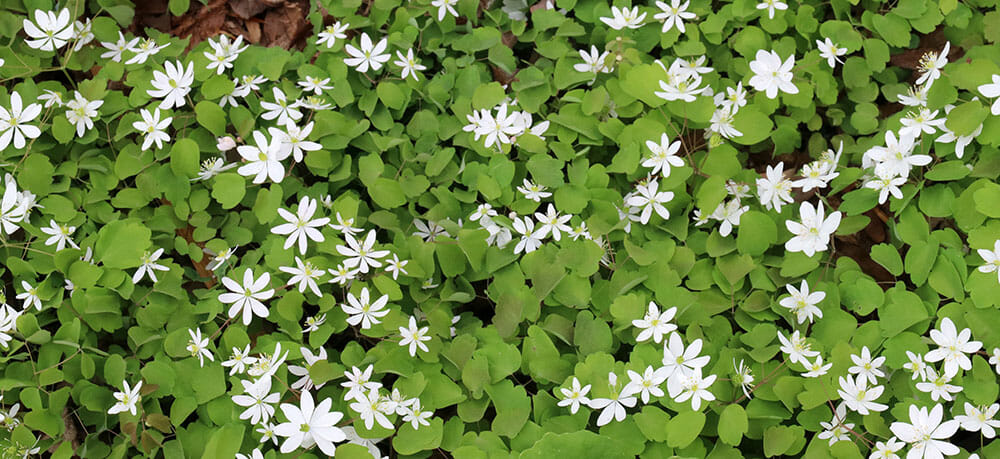
This dense patch of rue anemone {Thalictrum thalictroides) was in bloom at the Dupre residence on the Intown Atlanta Garden Tour this past weekend. Compare with this photo of wood anemone (Anemone quinquefolia), which more commonly grows in masses like this and is also blooming now.
Intown Atlanta Chapter
As an Earth Day Weekend event, the Atlanta Green Market Fair is showcasing participants who are advancing market-based solutions to environmental problems. Held at Ponce City Market, it will include a table for the Intown Chapter on April 23rd from 10-6 where we’ll have information about events, volunteer opportunities and other ways to expand your involvement with the Intown Atlanta Chapter. Come out and show your support for your local GNPS chapter and a great event for Earth Day.
Fringed Campion Chapter
The Fringed Campion Chapter will have a native plant walk on May 24th at Broxton Rocks Preserve at 10 a.m. Details and registration information can be found on our Facebook page.
North Metro Chapter
The North Metro Atlanta Chapter will be holding our Spring Plant Sale on April 30th at Old Rucker Farm and Park in Alpharetta. If you would like to donate plants or volunteer to help set up the day before the sale or on the day of, please email whitneybkramsey@gmail.com. On April 9th, members of the chapter will be holding a workday at the Dunwoody Nature Center. We will also be hosting a table at the Roswell Earth Fair on April 23rd, and if you’d like to volunteer to help, sign-up here. Also, our April workday at Old Rucker will be on April 24th.
Coastal Plain Chapter
The Coastal Plain Chapter has scheduled several native plant sales this spring. These events span the region and offer an opportunity to educate the public about the preferred habitat and growing conditions of many species that are not easy to find in traditional nurseries. The chapter advertises plant discounts for CPC members, and new memberships are often a bonus at sales events.
Amy Heidt and Paul Sumner handle the lion’s share of plant propagation duties, with several other CPC members helping to germinate seeds and prep plants for upcoming sales. Some UGA Tifton students are also working to propagate seeds as part of their studies.
Here’s the schedule for the next few weeks:
- April 9—Coastal WildScapes Plant Sale, Darien
- April 16—Wiregrass Farmers Market, Tifton
- May 5—Rosalynn Carter Butterfly Symposium, Plains
Plant lists are posted prior to the sales on the Coastal Plain Facebook page.
Check the GNPS Events page for additional Coastal Plain Chapter sales this spring.
North Georgia Mountains Chapter
The next meeting of the North Georgia Mountains Chapter will be 10:00 on Saturday April 9th at Young Harris College. After business, the presenter will be Laura Brown with the US Forest Service, on the topic of Native Plant Restoration and Management in the Chattahoochee-Oconee National Forest.
We have been able to select a couple spots for native garden installations at Meek’s Park in Blairsville, and we hope to begin the preparation for installation next week.
Augusta’s River Region Chapter
The local Apple Augusta presence has selected Augusta’s River Region Chapter to be the recipient of employee volunteer time and store donations. Each store has a People Operations Planner (POP) who works to locate qualified non-profits for their efforts. The Augusta POP is a native plant person! We are excited to have them work with us to expand GNPS endeavors in the Central Savannah River Area.
Augusta’s River Region will be participating in the Earth Day trash clean ups on April 23rd hosted by the Savannah RiverKeeper and the Phinizy Center for Water Sciences. Volunteers need to contact Mary at augusta@gnps.org for more information on how to sign up to receive a t-shirt and lunch ticket, provided by Phinizy.
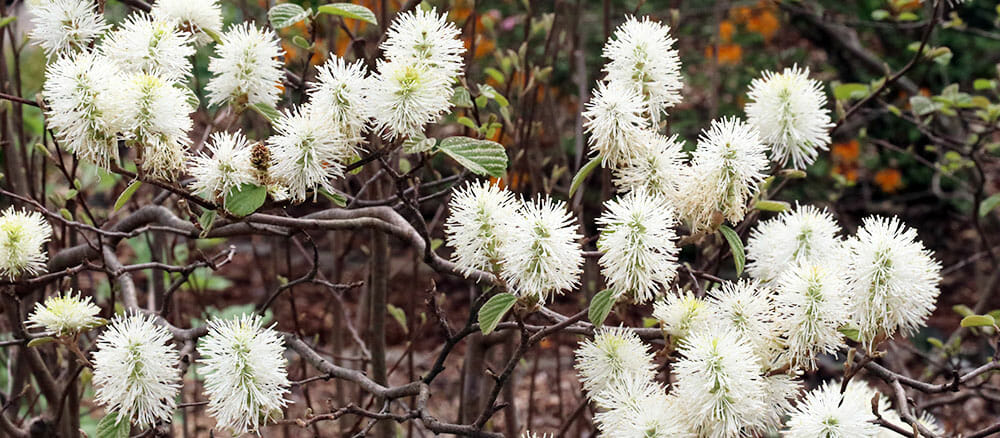
Also seen on the Intown Atlanta Garden Tour was this fothergilla (Fothergilla major) at the Smith residence.
|